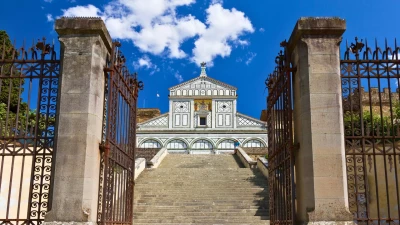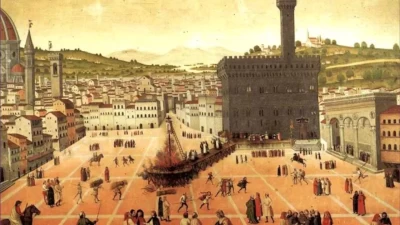Mary and Mario
 In the shadow of the Basilica of San Miniato al Monte, with a view that embraces the entire city of Florence, lies the Cemetery of the Holy Doors, a place of eternal rest that, since its inauguration in 1848, designed by the architect Niccolò Matas (the same behind the facade of the Basilica of Santa Croce), has become the final dwelling place for many prominent Florentine personalities. This sacred place, which extends around the basilica and the monastery, has become a point of reference for those wishing to leave this world under the benevolent gaze of the city of the Lily.
In the shadow of the Basilica of San Miniato al Monte, with a view that embraces the entire city of Florence, lies the Cemetery of the Holy Doors, a place of eternal rest that, since its inauguration in 1848, designed by the architect Niccolò Matas (the same behind the facade of the Basilica of Santa Croce), has become the final dwelling place for many prominent Florentine personalities. This sacred place, which extends around the basilica and the monastery, has become a point of reference for those wishing to leave this world under the benevolent gaze of the city of the Lily.
Among the numerous tombs of illustrious citizens, from Carlo Collodi to Pietro Annigoni, through Giovanni Spadolini and Vasco Pratolini, stand out those of Mario and Maria Grazia Mazzone, two young people whose tragic story has touched the hearts of many, immortalized in the statues that adorn their tombs since 1947. The effigies portray them with a serene and smiling expression, a portrait of elegance and joy despite their premature fate. Mario, who passed away at just twenty-three years old in 1944 following the explosion of a bomb in Germany during the Second World War, and Maria Grazia, taken away by tuberculosis just a year later, were united in death as in life by the decision of their mother, Emma Spulcioni Mazzone, to bury them together in the Cemetery of the Holy Doors. Emma wanted her children to be remembered for their indomitable spirit and their joy of living, despite adversities.
Mario, who passed away at just twenty-three years old in 1944 following the explosion of a bomb in Germany during the Second World War, and Maria Grazia, taken away by tuberculosis just a year later, were united in death as in life by the decision of their mother, Emma Spulcioni Mazzone, to bury them together in the Cemetery of the Holy Doors. Emma wanted her children to be remembered for their indomitable spirit and their joy of living, despite adversities.
The statues of the Mazzones, with their eternally young gaze turned towards the Florentine panorama, symbolize not only the memory of two lives cut too short but also the resilience of maternal love and the ability to find beauty and peace even in the deepest pain. These silent yet eloquent figures watch over the cemetery's restful, symbols of hope and that timeless beauty that only Florence can offer, making the Cemetery of the Holy Doors not just a burial place but a sanctuary of memories, love, and art, all under the immortal gaze of the city.
Altri articoli

Girolamo Savonarola was burnt at the stake
The famous painter Sandro Botticelli destroyed some of his works representing nudes.

Santa Reparata Church and the mosaic carpet
The cathedral hides a treasure: the archaeological area.

Dante's Florence
Remember that at the time Dante entered public life an extraordinary activity manifested itself in all branches of public works

Badia del Buonsollazzo
Dante himself, two centuries after his death, placed "the Great Baron" in the 'Paradiso'

